Signal to quantization noise in quantized sinusoidal
In problem 4.37 of DSP-Proakis [1], the task is to analyze the total harmonic distortion in quantized sinusoidal, where .
In problem 4.37 of DSP-Proakis [1], the task is to analyze the total harmonic distortion in quantized sinusoidal, where .
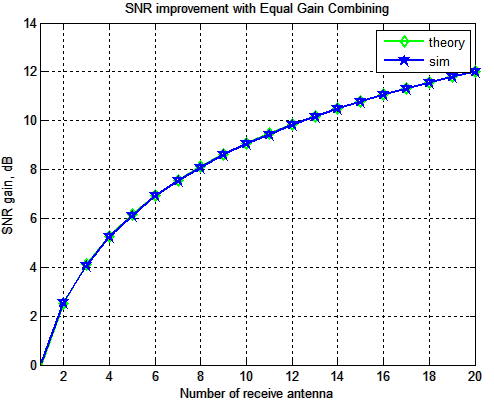
This is the second post in the series discussing receiver diversity in a wireless link. Receiver diversity is a form of space diversity, where there are multiple antennas at the receiver. The presence of receiver diversity poses an interesting problem – how do we use ‘effectively‘ the information from all the antennas to demodulate the…
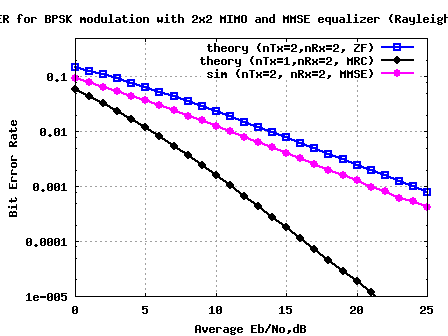
In a previous post, we had discussed a 2×2 MIMO transmission using BPSK modulation in Rayleigh channel with a Zero Forcing equalizer. The simulated results with the 2×2 MIMO system with zero forcing equalizer showed matching results as obtained in for a 1×1 system for BPSK modulation in Rayleigh channel. In this post, we will…
IEEE 802.11ac Very High Throughput (for <6GHz band) is an upcoming standard which is development by IEEE standardization committee. The mandate of Task Group AC is supposed to enhance the High Throughput rates achieved by 802.11n. As described in the document VHT below 6GHz PAR plus 5C’s (802.11-08/0807r4) the group has the following objectives :
In the previous post on Batch Gradient Descent and Stochastic Gradient Descent, we looked at two iterative methods for finding the parameter vector which minimizes the square of the error between the predicted value and the actual output for all values in the training set. A closed form solution for finding the parameter vector is possible, and in this post…
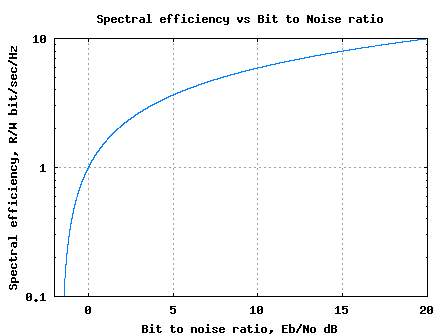
This is the second post in the series aimed at developing a better understanding of Shannon’s capacity equation. In this post let us discuss the bounds on communication given the signal power and bandwidth constraint. Further, the following writeup is based on Section 12.6 from Fundamentals of Communication Systems by John G. Proakis, Masoud Salehi
In an earlier post, it was mentioned that delta modulator without the quantizer is identical to convolving an input sequence with . Let us first try to validate that thought using a small MATLAB example and using the delta modulator circuit shown in Figure 9.13a of DSP-Proakis [1]. % delta modulation xn = sin(2*pi*1/64*[0:63]); xhatn…
In Problem 4.36 of DSP-Proakis [1], the task is to provide insights into harmonic distortion which may be present in practical sinusoidal generators. Consider the signal , where . My take: The discrete time signal of fundamental period can consist of frequency components separated by radians or cycles (Refer Section4.2 in [1]). The Fourier series…
Hi, Those visiting the blog might have noticed a fresh look to the dspLog. This new feel is thanks to the Thesis Magazine Skin provided by FourBlogger Skins. Click here to view more details. There some more tinkering required at some places. But, in general most of the settings are taken care. Hope you like…

The post on thermal noise described the noise produced by resistor ohms over bandwidth at temperature Kelvin. In this post, let us define the noise voltage at the input and output of a resistor network and further use it to define the Noise Figure of such a network.
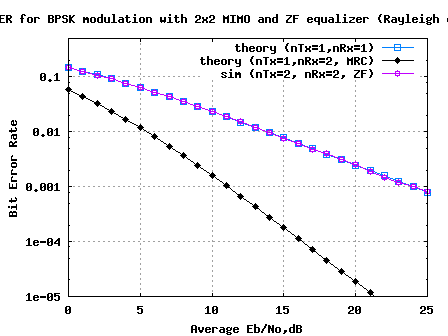
We had discussed three Single Input Multiple Output (SIMO also known as receive diversity) schemes – Selection combining, Equal Gain Combining, Maximal Ratio Combining and a Multiple Input Single Output (MISO, also known as transmit diversity) scheme – Alamouti 2×1 STBC. Let us now discuss the case where there a multiple transmit antennas and multiple…
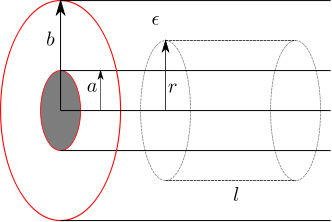
Question 16 on electromagnetics from GATE (Graduate Aptitude Test in Engineering) 2012 Electronics and Communication Engineering paper. Q16. A coaxial cable with an inner diameter of 1mm and outer diameter of 2.4mm is filled with a dielectric of relative permittivity 10.89. Given , the characteristic impedance of the cable is (A) (B) (C) (D) Solution To…

In TETRA specifications, one of the modulation technique used is Differential 8 Phase Shift Keying (D8PSK). We will discuss the bit error rate with non-coherent demodulation of D8PSK in Additive White Gaussian Noise (AWGN) channel.
In this post, let us try to understand Gray codes and their usage in digital communication. Quoting from Wiki entry on Gray code [Gray-Wiki], The reflected binary code, also known as Gray code after Frank Gray, is a binary numeral system where two successive values differ in only one digit. In a digital communication system,…